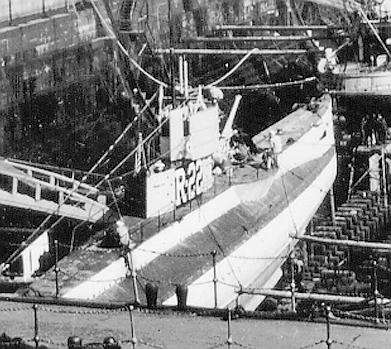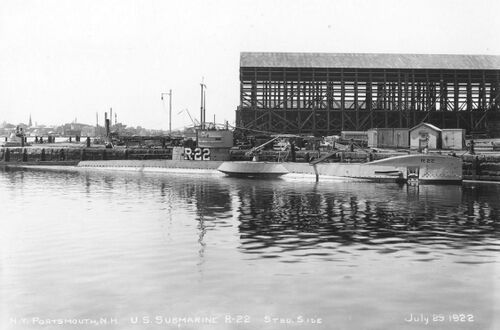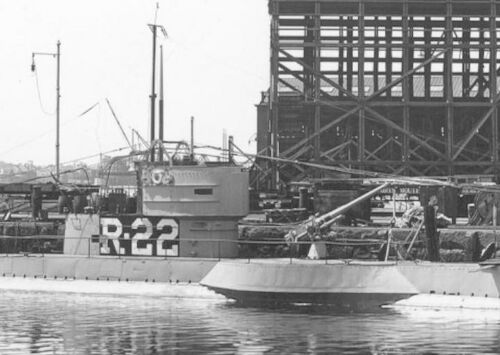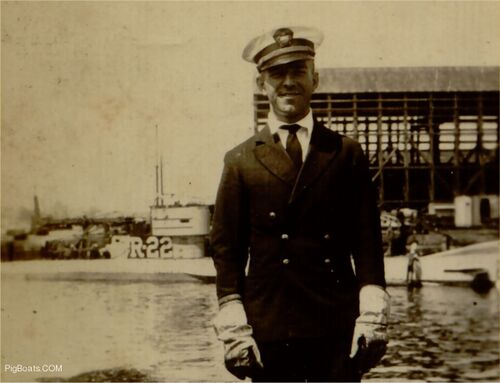R-22: Difference between revisions
Pbcjohnston (talk | contribs) mNo edit summary |
Pbcjohnston (talk | contribs) Added captions |
||
| Line 2: | Line 2: | ||
[[File:R-22 dry dock.jpg|left|500px]] | [[File:R-22 dry dock.jpg|left|500px]] | ||
<div style="text-align: justify;"><span style="color:#00008B">R-22 is shown here in drydock, likely at the Portsmouth Navy Yard in Kittery, ME. approximately 1922. This was probably the yard period in which she received the bow buoyancy tank seen in the photos below. | |||
<small>Milne Special Collections, University of New Hampshire Library, Durham, N.H. Used with permission.</small> | |||
[[File:Red bar sub new.jpg]] | |||
[[File:R-22 pierside.jpg|left|500px]] | [[File:R-22 pierside.jpg|left|500px]] | ||
<div style="text-align: justify;"><span style="color:#00008B">R-22 seen pierside at the Portsmouth Navy Yard in Maine, July 29, 1922. She has just completed conversion work that added a bulbous bow buoyancy tank. Simon Lake's design for the R-boats and the subsequent [[S-2|'''S-2 (SS-106)''']] were shown to be wet boats while surfaced, with seas frequently breaking against the conning tower fairwater. In an attempt to correct this problem, Lake designed a buoyancy tank that was added to the bow with the idea that the added buoyancy would make the bow ride over the waves instead of burrowing into them. Since the boat had already been delivered and commissioned into the Navy, Portsmouth undertook the conversion work. With this new profile R-22 and S-2 were reminiscent of several British submarine designs with raised bows. | |||
<small>U.S. Navy photo.</small> | |||
[[File:Red bar sub new.jpg]] | |||
[[File:R-22 s-2 bow.jpg|left|500px]] | [[File:R-22 s-2 bow.jpg|left|500px]] | ||
<div style="text-align: justify;"><span style="color:#00008B">A closeup of the R-22's bow from the photo above. This shows details of the new bow buoyancy tank. The tank was built onto the main deck, and the old deck line can be seen between the boat's name and the draft marks below it. | |||
<small>U.S. Navy photo.</small> | |||
[[File:Red bar sub new.jpg]] | |||
[[File:R-22 unusual gun palatform.jpg|left|500px]] | [[File:R-22 unusual gun palatform.jpg|left|500px]] | ||
When the 3"/50 caliber Mk 6 gun was added, the narrow deck required that an expanded sponson be added to give the gun crew room to train and elevate the gun. | |||
<small>U.S. Navy photo.</small> | |||
[[File:Red bar sub new.jpg]] | |||
[[File:R-22 w james J Hughes 1922.jpg|left|500px]] | |||
Lieutenant James Joseph Hughes photographed standing in front of the R-22 at Portsmouth Navy Yard on or about July 29, 1922. Hughes was likely assigned to the R-22 when this photo was taken, perhaps as her Executive Officer. He may have been leaving the boat to move on to command of the USS [[O-9|'''O-9 (SS-70)''']] in about two months from the time this photo being taken. Why his is wearing heavy work gloves with a dress uniform is a mystery. | |||
Hughes was to have a number of submarine commands over the years. The O-9, the [[O-13|'''O-13 (SS-74)''']], the [[O-7|'''O-7 (SS-68)''']], and the [[R-18|'''R-18 (SS-95)''']]. | |||
His most notable command was a surface command, the river gunboat USS Panay (PR-5) that was sunk by bombing by the Japanese while on the Yangtze River in 1937. The bomb blew him off the bridge and broke his hip, for which he was awarded Purple Heart. As the boat sank the crew made it to shore and hid in the reeds until rescue. His leadership that day was distinguished. The unprovoked sinking of the Panay, nearly four years before Pearl Harbor, very nearly catapulted the U.S. into war with Japan. Only a Japanese admission of guilt forestalled war at that time. | |||
His final command was the cargo ship USS Electra (AK-21) which was torpedoed by the Germans but survived and his efforts to save the ship resulted in him being awarded the Navy Commendation Medal with a Combat V. He was relieved of command on June 23, 1943 and released from active duty due to medical reasons, likely the result of continuing problems from his injuries aboard the Panay. | |||
<small>Photo in the private collection of Ric Hedman</small> | <small>Photo From Hughes Private Scrapbook, now in the private collection of Ric Hedman. Career data from Wolfgang Hechler and Ron Reeves.</small> | ||
[[File:Red bar sub new.jpg]] | [[File:Red bar sub new.jpg]] | ||
Revision as of 19:26, 30 September 2023

Milne Special Collections, University of New Hampshire Library, Durham, N.H. Used with permission.

U.S. Navy photo.

U.S. Navy photo.

When the 3"/50 caliber Mk 6 gun was added, the narrow deck required that an expanded sponson be added to give the gun crew room to train and elevate the gun.
U.S. Navy photo.

Lieutenant James Joseph Hughes photographed standing in front of the R-22 at Portsmouth Navy Yard on or about July 29, 1922. Hughes was likely assigned to the R-22 when this photo was taken, perhaps as her Executive Officer. He may have been leaving the boat to move on to command of the USS O-9 (SS-70) in about two months from the time this photo being taken. Why his is wearing heavy work gloves with a dress uniform is a mystery.
Hughes was to have a number of submarine commands over the years. The O-9, the O-13 (SS-74), the O-7 (SS-68), and the R-18 (SS-95).
His most notable command was a surface command, the river gunboat USS Panay (PR-5) that was sunk by bombing by the Japanese while on the Yangtze River in 1937. The bomb blew him off the bridge and broke his hip, for which he was awarded Purple Heart. As the boat sank the crew made it to shore and hid in the reeds until rescue. His leadership that day was distinguished. The unprovoked sinking of the Panay, nearly four years before Pearl Harbor, very nearly catapulted the U.S. into war with Japan. Only a Japanese admission of guilt forestalled war at that time.
His final command was the cargo ship USS Electra (AK-21) which was torpedoed by the Germans but survived and his efforts to save the ship resulted in him being awarded the Navy Commendation Medal with a Combat V. He was relieved of command on June 23, 1943 and released from active duty due to medical reasons, likely the result of continuing problems from his injuries aboard the Panay.
Photo From Hughes Private Scrapbook, now in the private collection of Ric Hedman. Career data from Wolfgang Hechler and Ron Reeves.
Page created by:
Ric Hedman & David Johnston
1999 - 2023 - PigBoats.COM©
Mountlake Terrace, WA, Norfolk, VA
webmaster at pigboats dot com
